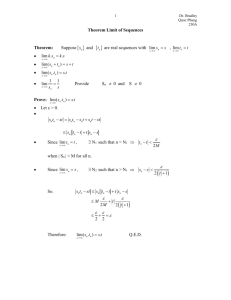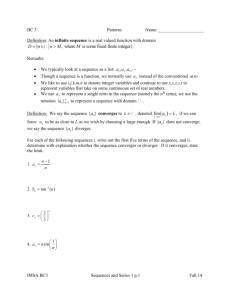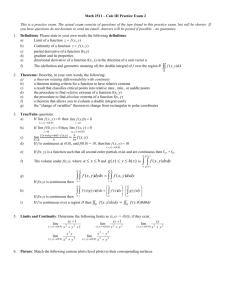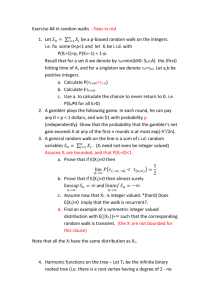View/Download - Atlantic International University
advertisement
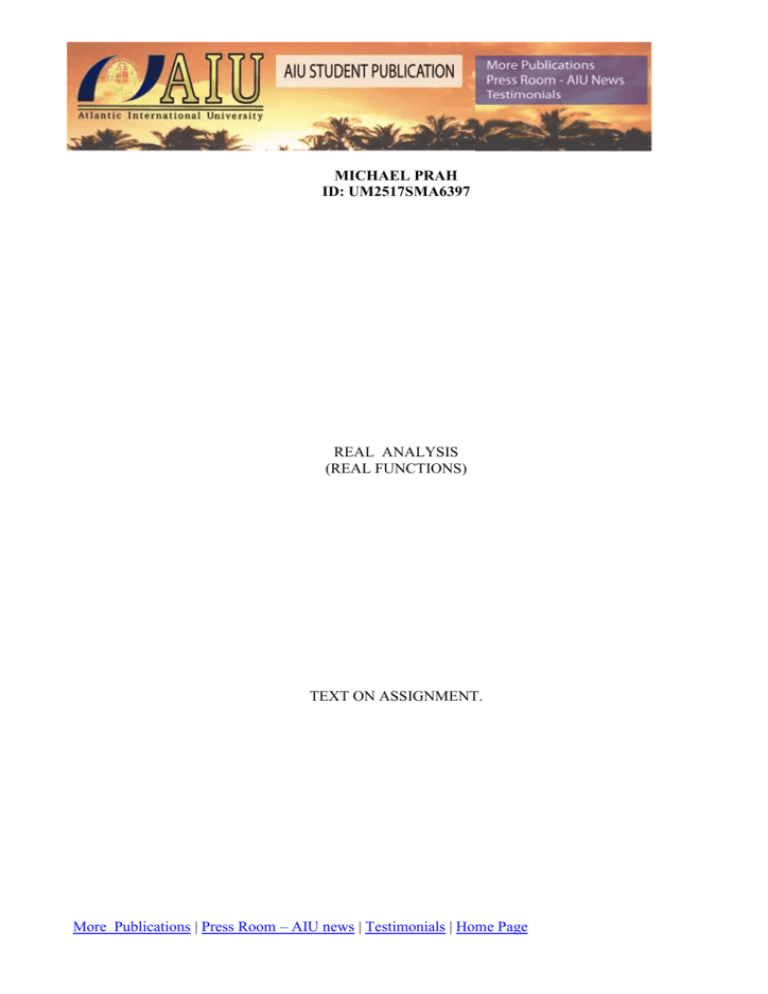
MICHAEL PRAH
ID: UM2517SMA6397
REAL ANALYSIS
(REAL FUNCTIONS)
TEXT ON ASSIGNMENT.
More Publications | Press Room – AIU news | Testimonials | Home Page
ATLANTIC INTERNATIONAL UNIVERSITY.
More Publications | Press Room – AIU news | Testimonials | Home Page
REAL ANALYSIS
REAL NUMBERS
INTRODUCTION
Real analysis is, roughly speaking, the modern setting for calculus, ‘real’ alluding to the field of real
numbers.
This ext on real numbers discusses of sequence that culminates in the concept of convergence, the
fundamental concept of analysis. We shall look at Weierstrass-Bolzano theorem, normally a theorem
about bonded sequence, is in essence a property of closed intervals and Cauchy’s Criterion is a test for
convergence, especially useful in t he theory of infinite series and finally we shall look at a dissection of
convergence into two more general limiting operations.
More Publications | Press Room – AIU news | Testimonials | Home Page
CONTENTS
PAGE
…
…
…
…
…
…
…
…
…
2
…
…
…
…
…
…
…
…
…
4
ULTIMATELY, FREQUENTLY
…
…
…
…
…
…
…
…
7
NULL SEQUENCE …
…
…
…
…
…
…
…
…
9
…
…
…
…
…
…
…
…
12
SUBSEQUENCES, WEIERSTRASS-BOLZANO THEOREM
…
…
…
…
15
CAUCHY’S CRITERION FOR CONVERGENCE …
…
…
…
…
…
17
MONOTONE SEQUENCES …
…
…
…
…
…
18
REAL NUMBERS
…
BOUNDED SEQUENCES
…
CONVERGENT SEQUENCE
…
…
…
More Publications | Press Room – AIU news | Testimonials | Home Page
CHAPTER ONE
BOUNDED SEQUENCES
Bounded Sets
V. S. Shipachev 1998 P. 28
A set x is said to be bounded from above (from below) if there is a number c such that the inequality x ≤
c (x ≥ c) is satisfied for any x Є X. in this case the number C is the upper (lower) bound of the set x.
A set which is bounded both from above and from below is said to be bounded. Thus, for instance, any
finite interval a, b, a, b, a, b, a, b is bounded. The interval a, is a set bounded from below but
not bounded above, and the entire number line , is a set not bounded wither from above or
from below.
Any set x bounded from above (from below) evidently has infinitely many upper (lower) bounds.
Indeed, if the number c is an upper (lower) bound of the set x, then any number c; which is larger
(smaller) than the number c, is also an upper (lower) bound of the set x since the validity of the
inequality x c implies the validity of the inequality x cx c
Definition of bounded sequence
Sterling, K. Berberian 1994 P. 33-34
A sequence (Xn) of real numbers is said to be bounded if the set n : n is bounded.
A sequence that is not bounded is said to be unbounded.
Remark
A sequence (Xn) in R is bounded if and only if there exist a positive number K such that n for
all n.
More Publications | Press Room – AIU news | Testimonials | Home Page
Proof
If
a Xn b for
all
n
and
if
a b (for
example)
then
a and
b ,
thus
a a Xn b b by the following.
Theorem 1
For real number a,b,c,x:
4
1) a 0
6) a a
2) a a 2
7) ab a b
3) if x 0 and x 2 a 2 , then x a
8) a a a
4) a 0 a 0; a 0 a 0
9) x c c x c
5) a b a 2 b2 a b
10) a b a b
2
11) a b a b
therefore Xn k by theorem (1)
Example
Every constant sequence Xn x for all n.) is bounded. The sequence Xn 1 is bounded.
n
Theorem 2
If Xn and Yn are bounded sequences in R , the sequences Xn Yn and XnYn are also bounded.
Proof
If Xn and Yn then.
Xn Yn Xn Yn and XnYn Xn Yn .
Monotonic Sequence theorem
James Stewart 4th edition P. 734
More Publications | Press Room – AIU news | Testimonials | Home Page
Every bounded, monotonic sequence is convergent.
Proof
Suppose an is an increasing sequence. Since an is bounded, the set = an
n has an upper
bound. By the completeness Axion if has a least upper bound L. Given 0, L is not an upper
bound for S. therefore aN L for some integer N.
But the sequence is increasing so an aN for every n N . Thus, if n N we have an L
So 0 L an since an L. thus L an , whenever n N
5
So lim n an L .
More Publications | Press Room – AIU news | Testimonials | Home Page
6
More Publications | Press Room – AIU news | Testimonials | Home Page
CHAPTER TWO
ULTIMATELY, FREQUENTLY.
Definition
Sterling K. Berberian 1994 P. 35-36
Let (Xn) be a sequence in a set x and let A be a subset of x
(i)
we say that Xn A ultimately if Xn belongs to A from some index onward that is, there is an
index N such that Xn A for all n N ; symbolically,
N n N Xn A
(ii)
we say that Xn A frequently is for every index N there is an index n N for which
Xn A ; symbolically.
N n N Xn A
Example
Let Xn 1 , let 0 and let A 0,; then Xn A ultimately.
n
Proof
Choose an index N such that 1
N
, n N 1
N
then.
Example
For each positive integer n, let Sn be a statement (which may be either true or false).
Let A = {n Є |P : Sn is true}
More Publications | Press Room – AIU news | Testimonials | Home Page
We say that Sn is true frequently is n A frequently, and that Sn is true ultimately if n A ultimately.
For example, n 2 5n 6 0 ultimately (infact, for n 4); ) and n is frequently divisible by 5 (infact,
for n = 5, n = 10, n = 15, etc).
Theorem 3
With notations as above, one and only one of the 7following conditions holds:
(1) Xn A ultimately
(2) Xn A frequently
Proof
To say that (1) is false means that, whatever index N is proposed, the implication
n N Xn A.
is false, so there must exist an index n N for which Xn A; is precisely the meaning of (2).
For example is (Xn) is an sequence in R then either Xn < 5 ultimately, or Xn 5 frequently, but not
both.
More Publications | Press Room – AIU news | Testimonials | Home Page
CHAPTER THREE
NULL SEQUENCE
Definition
Sterling K. Berberian 1994 P. 36-38
A sequence (Xn) in R is said to be null if, for every positive real number , Xn ultimately.
n is null.
For example, the sequence 1
Theorem 4
Let (Xn) and (Yn) be null sequences and let c R
Then;
1) (Xn) is bounded
2) (CSn) is null
3) (Xn + Yn) is null
4) if (bn) is a bounded sequence then (bnXn) is null
5) if (Zn) is a sequence such that Zn Xn ultimately, then (Zn) is also null.
Proof
(1)
with = 1, we have Xn ultimately; let N be an index such that Xn for all n > N. If K is
the larger of the numbers.
(1), X1 , X 2 , _ _ _ _ , X N , then X n K for every positive integer n, thus (Xn) is bounded.
(2). let 0 . Since (Xn) is null, there is an index N1 such that n N1 X n ,
2
More Publications | Press Room – AIU news | Testimonials | Home Page
so if N is the larger of N1 and N2 then n N Xn Yn Xn Yn
2
2
this proves that Xn Yn is null.
(3). let k be a positive real number such that bn k for all n. Given any 0, choose an index N such
that n N Xn ; then
k
n N bn n bn Xn k Xn , thus bn n is null.
9
(4). let k be a positive real number such that bn k for all n. Given any 0, choose an index N such
that; n N bn n bn n k n , thus bn n is null.
(2) is a special case of (4)
(5) By assumption, there is an index N1 such that n N1 n n
Given any 0, choose an index N2 such that n 2 n ;
If N = max 1, 2 then
n n n , thus n is null.
Theorem 5
If an a or a n a then the sequence (an - a) is null.
Poof
If an a then
an a an a a a 0
In particular, an a 0 and if an a 0 . Given any 0, choose an index N such that;
an a is null. The case that
an a is deduced by applying the foregoing to an a .
More Publications | Press Room – AIU news | Testimonials | Home Page
Example
Fix x R and let Xn = X for all n. The Constant sequence (Xn) is null if and only if x = 0.
Proof
The condition “ n ultimately” means x ; if this happens for every 0, then x = 0 (for, if
x 0 ) then 1 2 x is an embarrassment)
10
More Publications | Press Room – AIU news | Testimonials | Home Page
CHAPTER FOUR
CONVERGENT SEQUENCE
The Concept of a Convergent Sequence
Definition
V.S. Shipachev 1998 P. 36-37
The number a is the limit of the sequence n if for any positive number there is a number N such
that the inequality
n a
holds true for n > N.
A sequence which has a limit is said to be convergent. If the sequence n converges and has a
number a as its limit, then the symbolic notation is lim n a, or n a as n n .
A sequence which is not convergent is divergent,
Example
Using the definition of the limit of a sequence, we shall prove that,
lim
n
1
n n 1
we take an arbitrary number 0 . Since n 1
n which satisfy the inequality n 1
whence we find that n
n
1
1
, it follows that to find the values of
n 1
n 1
n
1
1
, it is sufficient to solve the inequality
,
n 1 n 1
n 1
1
More Publications | Press Room – AIU news | Testimonials | Home Page
consequently, we can take the integral part of the number
1 . Then the inequality
1
as N, that is
n 1 will be satisfied for all n . we have thus proved that
lim
n
1
n n 1
12
Definition
James Stewart 4th edition P. 729
A sequence an has the limit L and we write
lim
n
an L or an L as a , a
If for every 0 there is a corresponding integer N such that an L where n
If lim a a n exists, we say the sequence converges (of is convergent). Otherwise, we say the
sequence diverges (or s divergent).
Limit laws for sequence
James Stewart 4th edition P. 730
If an and bn are convergent sequences and c is a constant, then
lim
n
lim
n
lim
n
lim
n
an bn
an bn
Can C
anbn
lim
n
lim
n
lim
an
an
n
an
lim
lim
n n
lim
n
lim
n
bn
bn
bn
More Publications | Press Room – AIU news | Testimonials | Home Page
lim
an
lim
an
n
bn 0
if
lim
n
n bn
an
n
lim
lim
n
C C
13
The squeeze theorem for sequence is if an bn Cn for n n0 and
lim
n
lim
n
bn L
Example
Evaluate
lim
1n
n
n
if it exists.
Solution
lim
1n
n
n
lim
1
0
n n
Therefore by the theorem if
lim
1n
n
n
lim
n
an 0, then
lim
n
an 0
0.
Theorem 6
More Publications | Press Room – AIU news | Testimonials | Home Page
an
lim
n
Cn L, then.
The sequence r n is convergent if 1 r 1 and divergent for all other values of r
lim
n
0 if 1 r 1
r 1
1 if
Definition
A sequence an is called increasing if an an 1 for all n 1, that is, a1 a2 a3 ,..... If is called
decreasing if an an 1 for all n 1. It is called monotonic if it is either increasing or decreasing.
14
More Publications | Press Room – AIU news | Testimonials | Home Page
CHAPTER FIVE
SUBSEQUENCES, WEIERSTRASS-BOLZANO THEOREM
Steling K. Berberian, 1994 P. 43-44
Given a sequence x n , there are various ways of forming ‘subsequences’ for example, take every other
term, x1 , x3 , x5 ,.....; or take all terms for which the index is a prime number, x2 , x3 , x5 , x7 , x11,..........
The general idea is that one is free to discard any terms, as long as infinitely many terms remain.
Remark
Here’s is useful perspective on subsequences.
A sequence x n is a set x can be thought of as a function.
f : x, where f n = x n
A sequence of xn is obtained by specifying of strictly increasing function.
: and taking the composition function fo
f
|P
X
σ
|P
foσ
Thus, writing nk k , we have fo k f k f nk xnk
Theorem 7 (weierstrass- Bolzano theorem)
Every bounded sequence in R has a convergent subsequence.
Proof
More Publications | Press Room – AIU news | Testimonials | Home Page
Let an be a bounded sequence of real numbers. By the preceding theorem, an has a monotone
subsequence ank . Suppose, for example, that ank is increasing; it is also bounded =, so ank a for a
suitable real number a, and ank a .
The weierstrass-Bolzano theorem can be reformulated as a theorem about closed intervals:
Corollary
15
In a closed interval a,b, every sequence has a subsequence
that converges to a point of the interval.
Proof
Suppose n a, bn 1,2,3,...... . By the theorem, some subsequence is convergent to a point of R , say
xnk x : since a xnk b for all k, it follows that a x b, thus x a,b.
More Publications | Press Room – AIU news | Testimonials | Home Page
CHAPTER SIX
CAUCHY’S CRITERION FOR CONVERGENCE
Theorem 8 (Cauchy’s Criterion)
Steling K. Berberian 1994 P. 48-49
For a sequence a n in R, the following conditions are equivalent.
(a) an is convergent;
(b) for every 0, there is an index N such that am an whenever m and n are ;
Proof
(a) (b): say an a. if 0 then an a
2
ultimately, say for n ; if both m and n are
then, by the triangle inequality,
am an am a a an
am a a an
2
2
(b)
(a): Assuming (b), let’s show first that the sequence a n is bounded. Choose an index M such that
am an
for all m, n M . then, for all n M ,
an an am am am an am am ,
therefore the sequence a n is bounded, explicitly, if r max a1 , a2 ,............ am 1, am , then an r
for all n.
More Publications | Press Room – AIU news | Testimonials | Home Page
CHAPTER SEVEN
MONOTONE SEQUENCES
Monotone, monotonic function
Yule Bricks 2006 P. 116.
A function is monotone if it only increases or only decreases, f increases monotonically (is monotonic
increasing) if x y , implies f x that = f y
A function f decreases monotonically (is monotonic decreasing) if x y
A function f is strictly monotonically increasing is x y , implies that f x > f y and strictly
monotonically decreasing if x y , implies that f x < f y .
Definition
James Stewart 4th edition P. 733.
A sequence an is called increasing if an an1 for all n 1, that is, a1 a2 a3 ,....... It is called
decreasing if an an1 for all n 1. It is called monotonic if it is either increasing or decreasing.
Example
3
3
3
3
The sequence
for all n 1.
is decreasing because
n 5 n 1 5 n 6
n 5
(The right side is smaller because it has a larger denominator).
Definition
V.S. Shipachev 188 P. 42
The sequence xn is said to be increasing if xn xn1 for all n, non decreasing if xn xn1 for all n,
decreasing if xn xn1 for all n.
More Publications | Press Room – AIU news | Testimonials | Home Page
All sequence of these kinds are united by a common title of monotone sequences.
Increasing and decreasing sequences are also called strictly monotone sequences.
Here are some examples of monotone sequences.
(1) The sequence 1, 1 , 1 ,......, 1 ,........ is decreasing and bounded.
2 3
n
18
(2) The sequence 1,1, 1 , 1 , 1 , 1 ,........, 1 ....... is non increasing and bounded.
2 2 3 3
n
(3) The sequence 1,2,3……,n,…….. is increasing and bounded.
(4) The sequence 1,1,2,2,3,3,…..,n,n,…. Is non decreasing and unbounded.
(5) The sequence 1 , 2 , 3 ,...., n
,..... is increasing and bounded.
2 3 4
n 1
Or ‘a sequence in x’, whose nth term is xn
Various notations are used to indicated sequences, for example
xn , xn n , xn n1, xn n 1,2,3,......... .......... .......... ..........
Definition
A sequence an in R is said to be increasing if a1 a2 a3 ,..........., that is, if an an1 for all n;
increasing if
a1 a2 a3 ,........; and strictly decreasing if an an1 for all n.
A sequence that is either increasing or decreasing is said to be monotone; more precisely, one speaks of
sequences that are ‘monotone increasing ‘or ‘ monotone decreasing’.
More Publications | Press Room – AIU news | Testimonials | Home Page
RECOMMENDATON
The genda of this text can be recommended as a foundation of calculus including the fundamental
theorem and along was to develop those skills and attitudes that enable us to continue learning
mathematics on out own.
Some part of real analysis is an attempt to bring some significant pat of the theory of lebesgue integral a
powerful generalization calculus.
Real analysis can also be recommended for the application of applied Abstract algebra and introduction
to optimal control theory.
More Publications | Press Room – AIU news | Testimonials | Home Page
CONCLUSION
This text gives the fundamentals of real functions and I tried to present the material as completely,
strictly and simple as possible. The aim was no to convey certain quantity of knowledge in mathematics
but also to arouse an interest in any reader of this text.
Real functions can be used by mathematicians for theoretical material, and therefore for practical
purposes
Also it can be applied for mathematical prediction possible for complicated phenomena and
mechanisms.
Real functions can be applied to solve specific theoretical and practical problems to stimulate and
elaborate of newer abstract methods and branches of mathematics.
More Publications | Press Room – AIU news | Testimonials | Home Page
REFERENCES
James Stewart (1999) CALCULUS, BOSTON.
K. A. Stroud (2006) ENGINEERING MATHEMATICS, NEW YORK
Sterling K. Berberian (1994) A FIRST COURSE IN REAL ANALYSIS, NEW YORK
V. S. Shipachev (1988)HIGHER MATHEMATICS, RUSSIA
Yule Bricks (2006) DICTIONARY OF MATHEMATICS, NEW DELHI
More Publications | Press Room – AIU news | Testimonials | Home Page



